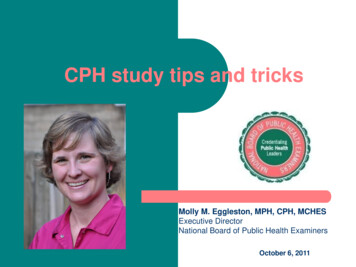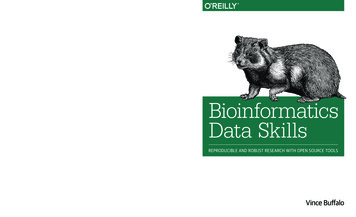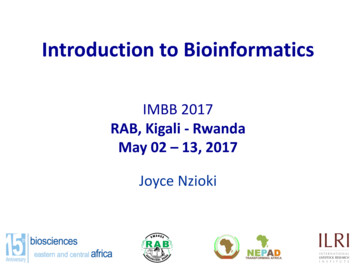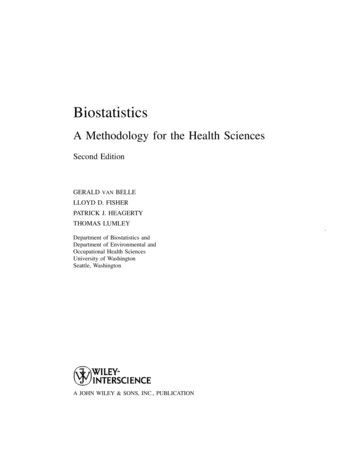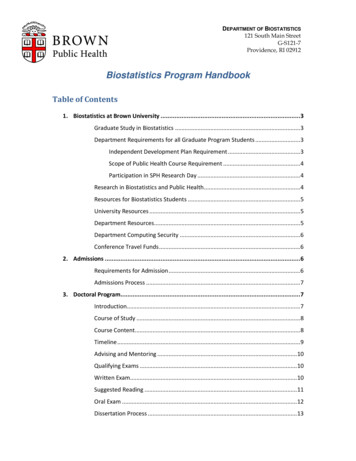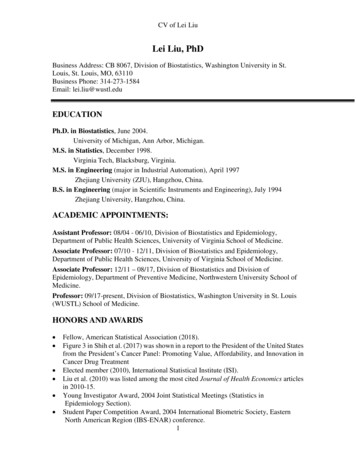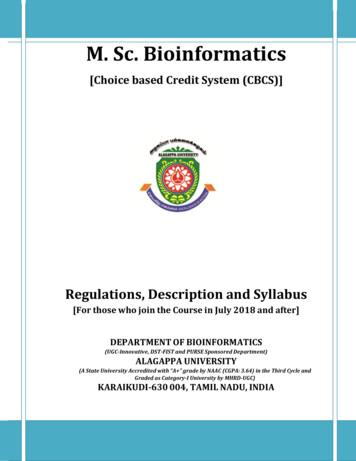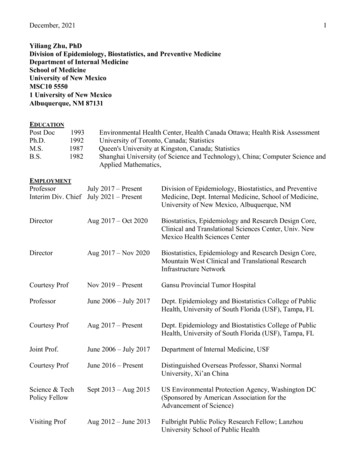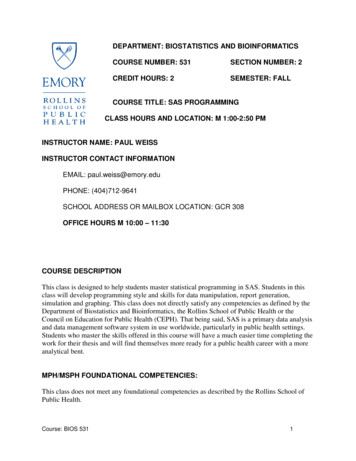
Transcription
DEPARTMENT: BIOSTATISTICS AND BIOINFORMATICSCOURSE NUMBER: 531SECTION NUMBER: 2CREDIT HOURS: 2SEMESTER: FALLCOURSE TITLE: SAS PROGRAMMINGCLASS HOURS AND LOCATION: M 1:00-2:50 PMINSTRUCTOR NAME: PAUL WEISSINSTRUCTOR CONTACT INFORMATIONEMAIL: paul.weiss@emory.eduPHONE: (404)712-9641SCHOOL ADDRESS OR MAILBOX LOCATION: GCR 308OFFICE HOURS M 10:00 – 11:30COURSE DESCRIPTIONThis class is designed to help students master statistical programming in SAS. Students in thisclass will develop programming style and skills for data manipulation, report generation,simulation and graphing. This class does not directly satisfy any competencies as defined by theDepartment of Biostatistics and Bioinformatics, the Rollins School of Public Health or theCouncil on Education for Public Health (CEPH). That being said, SAS is a primary data analysisand data management software system in use worldwide, particularly in public health settings.Students who master the skills offered in this course will have a much easier time completing thework for their thesis and will find themselves more ready for a public health career with a moreanalytical bent.MPH/MSPH FOUNDATIONAL COMPETENCIES:This class does not meet any foundational competencies as described by the Rollins School ofPublic Health.Course: BIOS 5311
CONCENTRATION COMPETENCIES:This class does not meet any foundational competencies as described by the Rollins School ofPublic Health.COURSE LEARNING OBJECTIVES:Students in this class will learn how to use SAS’s programming language to manipulatedata and solve complex statistical problems using simulation.EVALUATIONThere will be 4 projects comprising 75% of the final grade each. Two exams will comprise theremaining 25% (midterm 10%, final 15%). The Base SAS Certification Exam is an optionaltest that will not count towards the student’s grade. Students are encouraged to sit for thecertification exam; we are pleased to offer the exam with an Emory discount of approximately50% off the regular price. This Emory discount does not take the place of the one-time studentdiscount already offered by SAS, so students may take the exam with us using our discount and adifferent exam (or a retake of the base exam) with the student discount at a later date. The SASexam is optional and the resulting grade will not be figured into the students’ final gradesregardless of the result.GRADING: [96 A[91 – 96) A[86 – 91) B [81 – 86) B[76 – 81) B[66 – 76) CBelow 66 FCOURSE STRUCTURELecture 1: Introductions (Syllabus, The RSPH Network, SAS)Project handout distributed – Project #1 assignedProject #1 covers merging and manipulating data for processing. Since this classdoes not directly satisfy any competencies as defined by the Department of Biostatisticsand Bioinformatics, the Rollins School of Public Health or the Council on Education forPublic Health (CEPH) this homework project does not address any specific competency.However, data manipulation is the most fundamental skill in any analytical field and anessential tool for working with data in Public Health.Course: BIOS 5312
Lecture 2: Introducing SAS Datasets (Reading in, Creating)Since this class does not directly satisfy any competencies as defined by the Departmentof Biostatistics and Bioinformatics, the Rollins School of Public Health or the Council onEducation for Public Health (CEPH) this topic does not address any specific competency.However, SAS is one of the most commonly used statistical packages for processing andanalyzing data in the world. Being able to read in and process SAS datasets into the SASsystem is a foundational skill upon which all other SAS skills are built.Lecture 3: Sorting, Merging and ConcatenatingSince this class does not directly satisfy any competencies as defined by the Departmentof Biostatistics and Bioinformatics, the Rollins School of Public Health or the Council onEducation for Public Health (CEPH) this topic does not address any specific competency.However, datasets are often presented in multiple parts (e.g. multiple waves of a surveyor various components of a clinical study linked by record number) and being able toprocess and assemble an analytical dataset from a collection of smaller files is anessential tool in biostatistical methods.Lecture 4: Dates, Times and DatetimesProject #1 dueProject #2 assignedSince this class does not directly satisfy any competencies as defined by the Departmentof Biostatistics and Bioinformatics, the Rollins School of Public Health or the Council onEducation for Public Health (CEPH) this topic does not address any specific competency.SAS handles dates and times differently from other computer packages andunderstanding how they work in SAS opens up large avenues of programming facility.Project #2 covers report generation and table creation, two essential skills in analytics butnot specifically identified as competencies as defined by the Department of Biostatisticsand Bioinformatics, the Rollins School of Public Health or the Council on Education forPublic Health (CEPH).Lecture 5: Putting, Data Management and Report WritingSince this class does not directly satisfy any competencies as defined by the Departmentof Biostatistics and Bioinformatics, the Rollins School of Public Health or the Council onEducation for Public Health (CEPH) this topic does not address any specific competency.However, being able to assemble a dataset for presentation of results and writing theresults out to a data file or report are essential tools in every area of public health.Creating reports and filling in table shells by hand is an arduous process that is prone toerror. The amount of work required to fill in a table shell and then double-check it formistakes is time consuming and problematic. Being able to use SAS to create thenumbers for the table and then fill it in as well saves time and improves efficiency onCourse: BIOS 5313
multiple levels. While these skills may be undervalued as competencies, they areextremely valuable in the working environment and mastering these skills will increase astudent’s value in the workforce.Lecture 6: Midterm Exam (one hour)Introduction to DO statements, iterative coding and loopsProject #2 dueSince this class does not directly satisfy any competencies as defined by the Departmentof Biostatistics and Bioinformatics, the Rollins School of Public Health or the Council onEducation for Public Health (CEPH), the midterm exam does not address any specificcompetency. The exam will engage students’ ability to read and diagnose code. They willbe presented with a program (on paper) that is plagued with a number of coding errors.Students will identify the erroneous statements and provide a fix for each error. Studentsare awarded one point for each error they identify and an additional point if their fix issatisfactory. They will not receive the additional point if their fix does not work; they willalso lose a point if they make a change to a statement that works that results in makingthe statement wrong. For example, if the student sees: IF x 7 THEN y “TRUE”; andchanges the statement to: If X 7 then Y “TRUE”; they will not receive or lose anypoints. If the student sees IF x 7 THEN y “TRUE”; and changes the statement to: If(X 7) {Y “TRUE”}; then they will lose a point because the statement will no longerwork in SAS. Being able to debug code is an essential skill for any programminglanguage; a SAS master will be able to look at code in any setting and diagnose errorswithout having to rely on the enhanced SAS editor for hints on where the errors might be.The best SAS programmers will have an idea of where the error resides simply byanecdotal description of the problem. Our assessment at this juncture is a straightforwardassessment of students’ mastery of very basic concepts.Since this class does not directly satisfy any competencies as defined by the Departmentof Biostatistics and Bioinformatics, the Rollins School of Public Health or the Council onEducation for Public Health (CEPH), looping does not address any specific competency.This is a more advanced concept in data manipulation and plays a huge part insimulation. Being able to create and control looping structures opens huge avenues forprogramming that would otherwise be unavailable to the neophyte programmer.Lecture 7: ArraysProject #3 assignedSince this class does not directly satisfy any competencies as defined by the Departmentof Biostatistics and Bioinformatics, the Rollins School of Public Health or the Council onEducation for Public Health (CEPH) this topic does not address any specific competency.However, arrays are extremely useful as data structures in a host of programminglanguages. SAS Arrays are static structures comprised of variables which may or may notexist at the time the array is specified. Being able to refer to variables in a list by indexmakes code more efficient and can reduce the number of data defining statementsconsiderably.Course: BIOS 5314
Since this class does not directly satisfy any competencies as defined by the Departmentof Biostatistics and Bioinformatics, the Rollins School of Public Health or the Council onEducation for Public Health (CEPH) this topic does not address any specific competency.Project #3 gives students the opportunity to write a simulation to calculate the winningprobability of a common game of chance. Traditionally, we use two different games(Craps and Golo) alternating year by year. These games challenge students to writeefficient code to simulate the game under a simple strategy and then modify the strategyand compare the results. Simulation is an essential tool in statistical programming forcalculating probabilities in the absence of a closed form solution. Complex powerproblems, the impact of various assumptions and Bayesian posterior distributions are justa few examples of where simulation could provide an adequate answer when moremathematical options fail.Lecture 8: MacroProject #4 assignedSince this class does not directly satisfy any competencies as defined by the Departmentof Biostatistics and Bioinformatics, the Rollins School of Public Health or the Council onEducation for Public Health (CEPH) this topic does not address any specific competency.The SAS Macro language is an advanced topic that allows programmers to createmodular code and improve their efficiency at a slight cost in speed. The macro languageallows programmers to replace hard-coded values with macro variables and assign theirvalue once rather than having them assigned in multiple places directly. Cutting andpasting code is a common practice that is fraught with peril. Changing a “1” to a “2” in30 places in a copied block of code and then replicating the methodology for anadditional 20 blocks leads to long programs and many errors to debug. Using a macro tocall the block multiple times and change the value in a single parameter assignmentmakes the code easier to read and leaves much less room for error. Macro improvescoding style and efficiency but the change in processor leads to a decrease in speed.Students will learn about the macro processor and the tradeoff as they master this veryuseful advanced topic.Project #4 does not directly satisfy any competencies as defined by the Department ofBiostatistics and Bioinformatics, the Rollins School of Public Health or the Council onEducation for Public Health (CEPH). This project will allow students to develop a macrothat calls their simulation from project #3 and allow the user to define the parameters ofthe game under multiple strategies and such. This is the most challenging project of thesemester and is worth the least amount of points due to its degree of difficulty and timing.Lecture 9: IMLSince this class does not directly satisfy any competencies as defined by the Departmentof Biostatistics and Bioinformatics, the Rollins School of Public Health or the Council onEducation for Public Health (CEPH) this topic does not address any specific competency.The SAS Interactive Matrix Language is an advanced topic that allows programmers toCourse: BIOS 5315
manipulate data in matrices and vectors. This topic is not assessed directly by the projectsor exams.Lecture 10: GraphicsSince this class does not directly satisfy any competencies as defined by the Departmentof Biostatistics and Bioinformatics, the Rollins School of Public Health or the Council onEducation for Public Health (CEPH) this topic does not address any specific competency.The SAS System for Graphics is an advanced topic that allows programmers to displaydata in a host of different methods. This topic is not assessed directly by the projects orexams.Lecture 11: Miscellaneous topics / Catch-upProject #4 dueSince this class does not directly satisfy any competencies as defined by the Departmentof Biostatistics and Bioinformatics, the Rollins School of Public Health or the Council onEducation for Public Health (CEPH) this lecture does not address any specificcompetency. We build in some room at the end of the semester to cover any topics wewere unable to get to in the event of school closings and class cancellation beyond ourcontrol. Any topics covered in this class period will not be assessed on the final.Lecture 12: Final Exam (two hours)Introduction to DO statements, iterative coding and loopsProject #2 dueSince this class does not directly satisfy any competencies as defined by the Departmentof Biostatistics and Bioinformatics, the Rollins School of Public Health or the Council onEducation for Public Health (CEPH), the midterm exam does not address any specificcompetency. The exam will engage students’ ability to read and diagnose code. They willbe presented with a program (on paper) that is plagued with a number of coding errors.Students will identify the erroneous statements and provide a fix for each error. Studentsare awarded one point for each error they identify and an additional point if their fix issatisfactory. They will not receive the additional point if their fix does not work; they willalso lose a point if they make a change to a statement that works that results in makingthe statement wrong. For example, if the student sees: IF x 7 THEN y “TRUE”; andchanges the statement to: If X 7 then Y “TRUE”; they will not receive or lose anypoints. If the student sees IF x 7 THEN y “TRUE”; and changes the statement to: If(X 7) {Y “TRUE”}; then they will lose a point because the statement will no longerwork in SAS. Being able to debug code is an essential skill for any programminglanguage; a SAS master will be able to look at code in any setting and diagnose errorswithout having to rely on the enhanced SAS editor for hints on where the errors might be.The best SAS programmers will have an idea of where the error resides simply byanecdotal description of the problem. Our assessment at this juncture is comprehensive;students will be presented with looping and macro code to diagnose and debug as well asthe more fundamental concepts addressed in the base certification exam.Course: BIOS 5316
COURSE POLICIESHOMEWORK POLICY:Homework will be concentrated in two major term programming assignments. Theseassignments will allow you to apply the concepts we cover throughout the class. Final solutionsto these assignments may include calculating simple statistics from a dataset, generating tablesand reports, or building a simulation to explore some statistical phenomenon. Students will begraded on the accuracy of the presented information as well as the presentation of the programand results themselves. As programming is an art form, students will not be graded wholly onthe efficiency of their program this semester, but on their creativity in applying what they’velearned in solving the problem as well. Each assignment will have a number of deliverablesassigned as separate projects and all requiring SAS in some way. You will need to decide thebest way to solve the problems presented. You will turn in your program and sometimes someadditional documentation depending on the required deliverables.A midterm exam will be given in October and the final exam will be given on the last regularclass day. These exams will allow students an opportunity to demonstrate SAS skills bydebugging code written by another programmer. These exams will be administered by hard copy;students will not be allowed to use SAS to complete these exams.The optional Base SAS Certification Exam will be given during the regular final exam schedule.We will set up quizzes on Blackboard that you can take any time during the semester. Thequizzes and exams are good preparation for taking the SAS Certification exam. The SASCertification exam and the quizzes will not figure into the course grade. Additional reviewsessions will be scheduled for students who are interested in taking the SAS exam. Thesesessions will be outside of normal class times. Students who pass the certification exam willautomatically receive a 100 for the midterm or final exam.IMPORTANT INFORMATION:This class will serve as a prerequisite for BIOS 532 Statistical Computing. This classconcentrates on statistical programming and not on data analysis. Students who are looking for adata analysis course should consider other electives in Biostatistics. This class is very computerintensive, since becoming familiar with PC SAS will prepare students as they start consideringcareer options.Statisticians analyze data. Programmers solve problems. Statistical Programmers solve dataanalysis problems. You may have been trained to think like a statistician – this class will try toget you to think like a programmer. Therefore, a statistical background is not essential for thisclass, but previous programming experience could come in very handy. People who haveexperience in object-oriented languages like C and C will find R and S-Plus much easier topick up. People with experience in top-down languages like Pascal and BASIC will find SASmore to their liking.Course: BIOS 5317
As the instructor of this course I endeavor to provide an inclusive learning environment.However, if you experience barriers to learning in this course, do not hesitate to discussthem with me and the Office for Equity and Inclusion, 404-727-9877.RSPH POLICIESAccessibility and AccommodationsAccessibility Services works with students who have disabilities to provide reasonableaccommodations. In order to receive consideration for reasonable accommodations,you must contact the Office of Accessibility Services (OAS). It is the responsibility of thestudent to register with OAS. Please note that accommodations are not retroactive andthat disability accommodations are not provided until an accommodation letter has beenprocessed.Students who registered with OAS and have a letter outlining their academicaccommodations are strongly encouraged to coordinate a meeting time with me todiscuss a protocol to implement the accommodations as needed throughout thesemester. This meeting should occur as early in the semester as possible.Contact Accessibility Services for more information at (404) 727-9877 oraccessibility@emory.edu. Additional information is available at the OAS website nts/index.htmlHonor CodeYou are bound by Emory University’s Student Honor and Conduct Code. RSPHrequires that all material submitted by a student fulfilling his or her academic course ofstudy must be the original work of the student. Violations of academic honor includeany action by a student indicating dishonesty or a lack of integrity in academic ethics.Academic dishonesty refers to cheating, plagiarizing, assisting other students withoutauthorization, lying, tampering, or stealing in performing any academic work, and willnot be tolerated under any circumstances.The RSPH Honor Code states: “Plagiarism is the act of presenting as one’s own workthe expression, words, or ideas of another person whether published or unpublished(including the work of another student). A writer’s work should be regarded as his/herown property.”(http://www.sph.emory.edu/cms/current students/enrollment services/honor code.html)Course: BIOS 5318
COURSE CALENDARTentative Lecture OutlineWeek 1: Introductions (Syllabus, the RSPH Network, SAS)Week 2: SAS Datasets (Reading in and creating)Week 3: Sorting, Merging and ConcatenatingWeek 4: Dates, Times and DatetimesWeek 5: Putting, Data Management and Report WritingWeek 6: The DO Statement, Iterative Coding and LoopsWeek 7: ArraysWeek 8: MacroWeek 9: IMLWeek 10: GraphicsWeek 11: Miscellaneous Topics / Catch-upWeek 12: FINAL EXAM IN CLASSWeek 13: SAS Certification Exam (optional)COURSE OUTLINELecture 1: Introductions (Syllabus, The RSPH Network, SAS)Project handout distributed – Project #1 assignedProject #1 covers merging and manipulating data for processing. Since this classdoes not directly satisfy any competencies as defined by the Department of Biostatisticsand Bioinformatics, the Rollins School of Public Health or the Council on Education forPublic Health (CEPH) this homework project does not address any specific competency.However, data manipulation is the most fundamental skill in any analytical field and anessential tool for working with data in Public Health.Lecture 2: Introducing SAS Datasets (Reading in, Creating)Since this class does not directly satisfy any competencies as defined by the Departmentof Biostatistics and Bioinformatics, the Rollins School of Public Health or the Council onEducation for Public Health (CEPH) this topic does not address any specific competency.However, SAS is one of the most commonly used statistical packages for processing andanalyzing data in the world. Being able to read in and process SAS datasets into the SASsystem is a foundational skill upon which all other SAS skills are built.Lecture 3: Sorting, Merging and ConcatenatingSince this class does not directly satisfy any competencies as defined by the Departmentof Biostatistics and Bioinformatics, the Rollins School of Public Health or the Council onEducation for Public Health (CEPH) this topic does not address any specific competency.However, datasets are often presented in multiple parts (e.g. multiple waves of a surveyor various components of a clinical study linked by record number) and being able toCourse: BIOS 5319
process and assemble an analytical dataset from a collection of smaller files is anessential tool in biostatistical methods.Lecture 4: Dates, Times and DatetimesProject #1 dueProject #2 assignedSince this class does not directly satisfy any competencies as defined by the Departmentof Biostatistics and Bioinformatics, the Rollins School of Public Health or the Council onEducation for Public Health (CEPH) this topic does not address any specific competency.SAS handles dates and times differently from other computer packages andunderstanding how they work in SAS opens up large avenues of programming facility.Project #2 covers report generation and table creation, two essential skills in analytics butnot specifically identified as competencies as defined by the Department of Biostatisticsand Bioinformatics, the Rollins School of Public Health or the Council on Education forPublic Health (CEPH).Lecture 5: Putting, Data Management and Report WritingSince this class does not directly satisfy any competencies as defined by the Departmentof Biostatistics and Bioinformatics, the Rollins School of Public Health or the Council onEducation for Public Health (CEPH) this topic does not address any specific competency.However, being able to assemble a dataset for presentation of results and writing theresults out to a data file or report are essential tools in every area of public health.Creating reports and filling in table shells by hand is an arduous process that is prone toerror. The amount of work required to fill in a table shell and then double-check it formistakes is time consuming and problematic. Being able to use SAS to create thenumbers for the table and then fill it in as well saves time and improves efficiency onmultiple levels. While these skills may be undervalued as competencies, they areextremely valuable in the working environment and mastering these skills will increase astudent’s value in the workforce.Lecture 6: Midterm Exam (one hour)Introduction to DO statements, iterative coding and loopsProject #2 dueSince this class does not directly satisfy any competencies as defined by the Departmentof Biostatistics and Bioinformatics, the Rollins School of Public Health or the Council onEducation for Public Health (CEPH), the midterm exam does not address any specificcompetency. The exam will engage students’ ability to read and diagnose code. They willbe presented with a program (on paper) that is plagued with a number of coding errors.Students will identify the erroneous statements and provide a fix for each error. Studentsare awarded one point for each error they identify and an additional point if their fix issatisfactory. They will not receive the additional point if their fix does not work; they willCourse: BIOS 53110
also lose a point if they make a change to a statement that works that results in makingthe statement wrong. For example, if the student sees: IF x 7 THEN y “TRUE”; andchanges the statement to: If X 7 then Y “TRUE”; they will not receive or lose anypoints. If the student sees IF x 7 THEN y “TRUE”; and changes the statement to: If(X 7) {Y “TRUE”}; then they will lose a point because the statement will no longerwork in SAS. Being able to debug code is an essential skill for any programminglanguage; a SAS master will be able to look at code in any setting and diagnose errorswithout having to rely on the enhanced SAS editor for hints on where the errors might be.The best SAS programmers will have an idea of where the error resides simply byanecdotal description of the problem. Our assessment at this juncture is a straightforwardassessment of students’ mastery of very basic concepts.Since this class does not directly satisfy any competencies as defined by the Departmentof Biostatistics and Bioinformatics, the Rollins School of Public Health or the Council onEducation for Public Health (CEPH), looping does not address any specific competency.This is a more advanced concept in data manipulation and plays a huge part insimulation. Being able to create and control looping structures opens huge avenues forprogramming that would otherwise be unavailable to the neophyte programmer.Lecture 7: ArraysProject #3 assignedSince this class does not directly satisfy any competencies as defined by the Departmentof Biostatistics and Bioinformatics, the Rollins School of Public Health or the Council onEducation for Public Health (CEPH) this topic does not address any specific competency.However, arrays are extremely useful as data structures in a host of programminglanguages. SAS Arrays are static structures comprised of variables which may or may notexist at the time the array is specified. Being able to refer to variables in a list by indexmakes code more efficient and can reduce the number of data defining statementsconsiderably.Since this class does not directly satisfy any competencies as defined by the Departmentof Biostatistics and Bioinformatics, the Rollins School of Public Health or the Council onEducation for Public Health (CEPH) this topic does not address any specific competency.Project #3 gives students the opportunity to write a simulation to calculate the winningprobability of a common game of chance. Traditionally, we use two different games(Craps and Golo) alternating year by year. These games challenge students to writeefficient code to simulate the game under a simple strategy and then modify the strategyand compare the results. Simulation is an essential tool in statistical programming forcalculating probabilities in the absence of a closed form solution. Complex powerproblems, the impact of various assumptions and Bayesian posterior distributions are justa few examples of where simulation could provide an adequate answer when moremathematical options fail.Lecture 8: MacroProject #4 assignedCourse: BIOS 53111
Since this class does not directly satisfy any competencies as defined by the Departmentof Biostatistics and Bioinformatics, the Rollins School of Public Health or the Council onEducation for Public Health (CEPH) this topic does not address any specific competency.The SAS Macro language is an advanced topic that allows programmers to createmodular code and improve their efficiency at a slight cost in speed. The macro languageallows programmers to replace hard-coded values with macro variables and assign theirvalue once rather than having them assigned in multiple places directly. Cutting andpasting code is a common practice that is fraught with peril. Changing a “1” to a “2” in30 places in a copied block of code and then replicating the methodology for anadditional 20 blocks leads to long programs and many errors to debug. Using a macro tocall the block multiple times and change the value in a single parameter assignmentmakes the code easier to read and leaves much less room for error. Macro improvescoding style and efficiency but the change in processor leads to a decrease in speed.Students will learn about the macro processor and the tradeoff as they master this veryuseful advanced topic.Project #4 does not directly satisfy any competencies as defined by the Department ofBiostatistics and Bioinformatics, the Rollins School of Public Health or the Council onEducation for Public Health (CEPH). This project will allow students to develop a macrothat calls their simulation from project #3 and allow the user to define the parameters ofthe game under multiple strategies and such. This is the most challenging project of thesemester and is worth the least amount of points due to its degree of difficulty and timing.Lecture 9: IMLSince
The Base SAS Certification Exam is an optional test that will not count towards the student's grade. Students are encouraged to sit for the certification exam; we are pleased to offer the exam with an Emory discount of approximately 50% off the regular price. This Emory discount does not take the place of the one-time student discount already offered by SAS, so students may take the exam .

